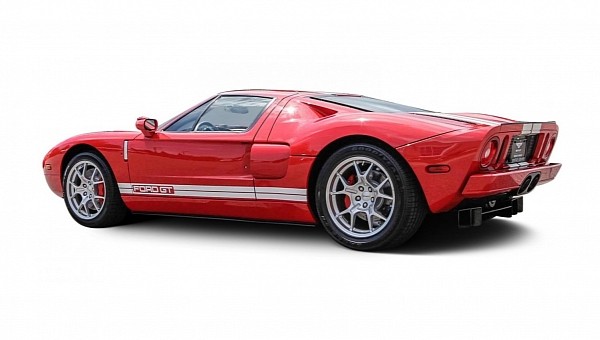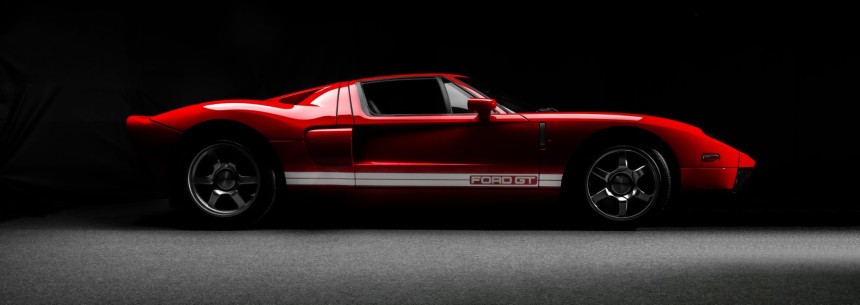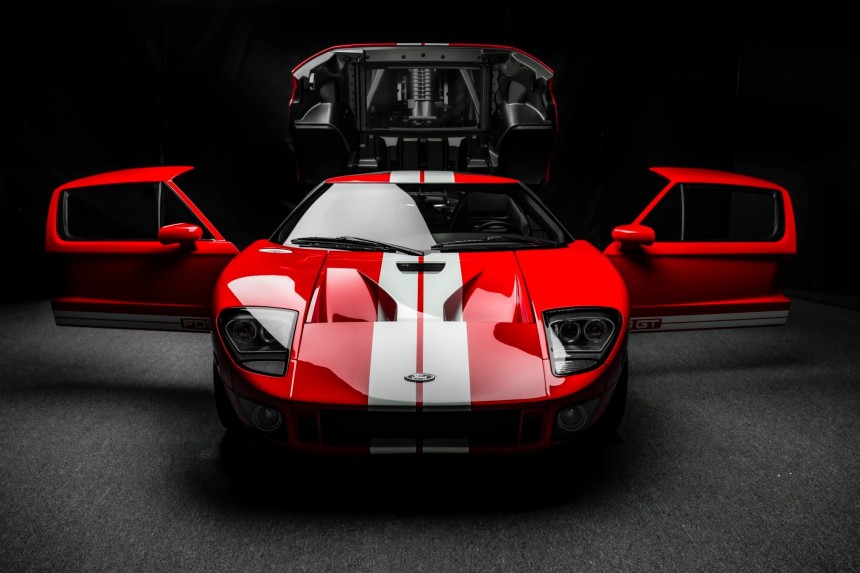Long before the Chevrolet Corvette switched to a mid-engine setup, the Ford Motor Company reinvented the GT40 as a road-going car. Not just any car, but a supercar-challenging land missile that used to retail at far less than what Ferrari charged for the sharp-looking Enzo. As if great value for money wasn’t enough, the first-generation GT was – and still is – an exotic despite its F-150 SVT Lightning-based supercharged V8.
Previewed by a concept at the 2002 North American International Auto Show in Detroit Motor City, the GT could have been very different had another concept been given the green light. Remember the GT90 from the 1995 edition of the Detroit Auto Show?
The very first Ford to display the Dearborn-based automaker’s New Edge design philosophy featured a quad-turbocharged V12 with quite a bit more horsepower and torque than the series-production GT. Earlier still, the GT70 was a limited-run sports car produced in six units with either a Cosworth I4 or the Cologne V6 engine.
Developed by Ford UK, the GT70 ran out of steam in 1973 due to regulation changes in the World Rally Championship, a cramped interior, and an underwhelming chassis that wasn’t good enough compared to the Porsche 911 of that era. The more promising GT90, on the other hand, didn’t reach production for two reasons.
First and foremost, using the bonded aluminum chassis Jaguar XJ220 wasn’t feasible from a financial standpoint. But more importantly, the Ford Motor Company couldn’t afford to step into Aston Martin’s territory because the British automaker was reinventing itself with Ford’s money back then. Not only did Aston Martin roll out the Jaguar XJS-based DB7 with the American automaker’s financial backing, but Ford also developed the Duratec V6-based V12 that would premiere in the DB7 Vantage. In other words, it wasn’t the right time for the brand from Dearborn to venture into the six-figure realm.
Given this background, why did the suits in Dearborn approve the GT for series production to the detriment of the GT90 and GT70? On the one hand, the crack team of designers and engineers had a tremendous role in convincing the higher-ups to give their blessing. Chief designer Camilo Pardo, chief engineer John Coletti, and the iconic Carroll Shelby come to mind. FoMoCo also wanted a halo car to celebrate its 100th anniversary in grand style. The GT40 Concept from the 2002 Detroit Auto Show was exactly that, and then some…
Rather than Ford, the peeps at Metro Technologies supplied the aluminum spaceframe of the GT. Complemented by double wishbones at every corner, anti-roll bars for both ends, and clever dampers, the chassis was designed in such a way that the fuel tank would fit within the transmission tunnel.
Rated at 17.5 gallons (make that 66.3 liters), said fuel tank quenches the thirst of a 90-degree V8 modified by Roush. There are many differences between it and the 5.4-liter engine in the F-150 Lightning, chief among which is the dry-sump oiling system. The block is also different, cast in aluminum rather than iron.
A twin-screw supercharger than a Roots-type unit also needs to be mentioned, along with a DOHC valvetrain instead of SOHC. Other highlights include port injection with dual fuel injectors per cylinder, high-lift camshafts, forged alloy pistons, a forged steel crankshaft, and beefier conrods.
Assembled on the Romeo plant’s Niche Line, this engine was exclusively connected to a six-speed manual transmission. Said transaxle came courtesy of UK-based Ricardo, the outfit that supplies twin-turbo V8s to McLaren.
From 380 horsepower and 450 pound-feet (610 Nm) in the second-generation Lightning, the free-breathing V8 leveled up to 550 horsepower and 500 pound-feet (678 Nm) in the first-generation GT. Peak torque is delivered at 4,500 revolutions per minute, and the 5.4-liter bad boy will gladly spin to 6,500 revolutions per minute.
3.4 seconds are needed to crack 60 miles per hour (97 kilometers per hour), and if you keep your foot planted on the loud pedal, the cross-plane V8 will stretch its legs all the way to 205 miles per hour (330 kilometers per hour).
Tipping the scales at 3,485 pounds (just over 1,580 kilograms), the GT features cast-alloy wheels from BBS wrapped in Goodyear summer-only performance tires. The Eagle F1 Supercar boots measure 235/45 by 18 inches up front and 315/40 by 19 out back.
The power rack-and-pinion steering system flaunts a 17:1 overall ratio, the final drive is listed by FoMoCo as 3.36:1, and the Brembo-supplied brakes measure 14 and 13.2 by 1.3 inches. Ford recommends 5W-50 full synthetic oil, and the oil capacity of the Modular-based V8 motor is 10 quarts (9.4 liters). Gifted with only 1.6 cubic feet (45.3 liters) of cargo volume, the GT boasts a 40-foot (12.1-meter) turning circle.
Bodied in aluminum by Ohio-based Mayflower Vehicle Systems, the GT was offered in six exterior colors: red, blue, yellow, silver, white, and black. A two-speaker audio system came standard, which is why the McIntosh premium audio system proved to be a popular option. In the second year of production, Ford canned silver for a gray finish. It also introduced a bi-tone option inspired by the GT40’s Gulf Oil livery.
Produced exclusively in left-hand drive, the GT could be converted into a roadster by the Genaddi Design Group. Available to order through Ford’s dealership network, the GTX1 could also be had with a boost to 700 ponies, Wilwood brakes, adjustable shocks, and some interior tweaks. The GT was expected to sell 4,500 units, but production stopped after 4,038 examples were finished. Only 28 vehicles were shipped to the United Kingdom, of which one was delivered to Jeremy Clarkson.
The very first Ford to display the Dearborn-based automaker’s New Edge design philosophy featured a quad-turbocharged V12 with quite a bit more horsepower and torque than the series-production GT. Earlier still, the GT70 was a limited-run sports car produced in six units with either a Cosworth I4 or the Cologne V6 engine.
Developed by Ford UK, the GT70 ran out of steam in 1973 due to regulation changes in the World Rally Championship, a cramped interior, and an underwhelming chassis that wasn’t good enough compared to the Porsche 911 of that era. The more promising GT90, on the other hand, didn’t reach production for two reasons.
First and foremost, using the bonded aluminum chassis Jaguar XJ220 wasn’t feasible from a financial standpoint. But more importantly, the Ford Motor Company couldn’t afford to step into Aston Martin’s territory because the British automaker was reinventing itself with Ford’s money back then. Not only did Aston Martin roll out the Jaguar XJS-based DB7 with the American automaker’s financial backing, but Ford also developed the Duratec V6-based V12 that would premiere in the DB7 Vantage. In other words, it wasn’t the right time for the brand from Dearborn to venture into the six-figure realm.
Given this background, why did the suits in Dearborn approve the GT for series production to the detriment of the GT90 and GT70? On the one hand, the crack team of designers and engineers had a tremendous role in convincing the higher-ups to give their blessing. Chief designer Camilo Pardo, chief engineer John Coletti, and the iconic Carroll Shelby come to mind. FoMoCo also wanted a halo car to celebrate its 100th anniversary in grand style. The GT40 Concept from the 2002 Detroit Auto Show was exactly that, and then some…
Rated at 17.5 gallons (make that 66.3 liters), said fuel tank quenches the thirst of a 90-degree V8 modified by Roush. There are many differences between it and the 5.4-liter engine in the F-150 Lightning, chief among which is the dry-sump oiling system. The block is also different, cast in aluminum rather than iron.
A twin-screw supercharger than a Roots-type unit also needs to be mentioned, along with a DOHC valvetrain instead of SOHC. Other highlights include port injection with dual fuel injectors per cylinder, high-lift camshafts, forged alloy pistons, a forged steel crankshaft, and beefier conrods.
Assembled on the Romeo plant’s Niche Line, this engine was exclusively connected to a six-speed manual transmission. Said transaxle came courtesy of UK-based Ricardo, the outfit that supplies twin-turbo V8s to McLaren.
From 380 horsepower and 450 pound-feet (610 Nm) in the second-generation Lightning, the free-breathing V8 leveled up to 550 horsepower and 500 pound-feet (678 Nm) in the first-generation GT. Peak torque is delivered at 4,500 revolutions per minute, and the 5.4-liter bad boy will gladly spin to 6,500 revolutions per minute.
Tipping the scales at 3,485 pounds (just over 1,580 kilograms), the GT features cast-alloy wheels from BBS wrapped in Goodyear summer-only performance tires. The Eagle F1 Supercar boots measure 235/45 by 18 inches up front and 315/40 by 19 out back.
The power rack-and-pinion steering system flaunts a 17:1 overall ratio, the final drive is listed by FoMoCo as 3.36:1, and the Brembo-supplied brakes measure 14 and 13.2 by 1.3 inches. Ford recommends 5W-50 full synthetic oil, and the oil capacity of the Modular-based V8 motor is 10 quarts (9.4 liters). Gifted with only 1.6 cubic feet (45.3 liters) of cargo volume, the GT boasts a 40-foot (12.1-meter) turning circle.
Bodied in aluminum by Ohio-based Mayflower Vehicle Systems, the GT was offered in six exterior colors: red, blue, yellow, silver, white, and black. A two-speaker audio system came standard, which is why the McIntosh premium audio system proved to be a popular option. In the second year of production, Ford canned silver for a gray finish. It also introduced a bi-tone option inspired by the GT40’s Gulf Oil livery.
Produced exclusively in left-hand drive, the GT could be converted into a roadster by the Genaddi Design Group. Available to order through Ford’s dealership network, the GTX1 could also be had with a boost to 700 ponies, Wilwood brakes, adjustable shocks, and some interior tweaks. The GT was expected to sell 4,500 units, but production stopped after 4,038 examples were finished. Only 28 vehicles were shipped to the United Kingdom, of which one was delivered to Jeremy Clarkson.


































